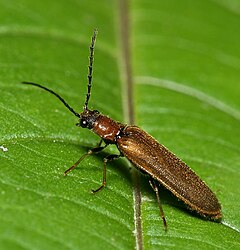Elateroidea
| Elateroidea | |
|---|---|

| |
| Denticollis linearis, a click beetle | |
| Scientific classification | |
| Domain: | Eukaryota |
| Kingdom: | Animalia |
| Phylum: | Arthropoda |
| Class: | Insecta |
| Order: | Coleoptera |
| Suborder: | Polyphaga |
| Infraorder: | Elateriformia |
| Superfamily: | Elateroidea Leach, 1815 |
| Families | |
|
About 15-20, see text | |
The Elateroidea are a large superfamily of beetles. It contains the familiar click beetles, fireflies, and soldier beetles and their relatives.
Certain clusters of families within the superfamily are more strongly related to one another; for example, the Elateridae have close ties to the Cerophytidae, Eucnemidae, and Throscidae, and some of these beetles can also "click".
Likewise, the Lampyridae are most closely related to the Phengodidae and Rhagophthalmidae; most members of these families are also bioluminescent, at least as larvae. This group of families also includes many taxa whose females are larviform, though this is also known from a few other families in the superfamily.
The validity and relationships of some families, such as Podabrocephalidae are not fully resolved. The family Rhinorhipidae has recently been removed to its own superfamily, with evidence that it is a basal taxon within Elateriformia dating to an Upper Triassic/Lower Jurassic split from other extant beetle lineages.[1]
Some recent morphological and molecular phylogenetic analyses find that Byrrhoidea is either a monophyletic or paraphyletic group closely related to Elateroidea.[2]
Extant Families
- Artematopodidae Lacordaire, 1857 – soft-bodied plant beetles (= Eurypogonidae)
- Brachypsectridae Leconte & Horn, 1883 – Texas beetles
- Cantharidae – soldier beetles
- Cerophytidae – rare click beetles
- Elateridae – click beetles (including Ampedidae, Balgidae, Dicronychidae, Drilidae, Lissomidae, Plastoceridae, Prosternidae, Protelateridae, Pyrophoridae, Synaptidae)
- Eucnemidae Eschscholtz, 1829 – false click beetles (including Anischiidae and Perothopidae)
- Iberobaeniidae Bocak et al., 2016
- Jurasaidae Rosa, Costa, Klamp & Kundrata, 2020
- Lampyridae – firefly beetles
- Lycidae – net-winged beetles
- Omethidae LeConte, 1861 – false firefly beetles (including Telegeusidae)
- Phengodidae LeConte 1861 – glowworm beetles (including Cydistinae[3])
- Podabrocephalidae Pic, 1930
- Rhagophthalmidae (sometimes in Phengodidae, might belong in Lampyridae)
- Sinopyrophoridae Bi & Li, 2019[4][5]
- Throscidae Laporte, 1840 – false metallic wood-boring beetles (= Trixagidae)
Extinct Families
- †Cretophengodidae Li, Kundrata, Tihelka & Cai, 2021
- †Mysteriomorphidae Alekseev and Ellenberger, 2019
Phylogeny
Based on Kusy et al. 2018[6] and 2020[4]
| Elateroidea | |
See also
References
- ^ Kusy, D., Motyka, M., Andujar, C. et al. Genome sequencing of Rhinorhipus Lawrence exposes an early branch of the Coleoptera. Front. Zool. 15, 21 (2018). https://doi.org/10.1186/s12983-018-0262-0
- ^ Beutel, R. G. (1995). "Phylogenetic analysis of Elateriformia (Coleoptera: Polyphaga) based on larval characters". Journal of Zoological Systematics and Evolutionary Research. 33 (3–4): 145–171. doi:10.1111/j.1439-0469.1995.tb00969.x. ISSN 1439-0469.
- ^ Kundrata, Robin; Blank, Stephan M; Prosvirov, Alexander S; Sormova, Eliska; Gimmel, Matthew L; Vondráček, Dominik; Kramp, Katja (2019-10-19). "One less mystery in Coleoptera systematics: the position of Cydistinae (Elateriformia incertae sedis) resolved by multigene phylogenetic analysis". Zoological Journal of the Linnean Society. 20 (4): 1259–1277. doi:10.1093/zoolinnean/zlz104. ISSN 0024-4082.
- ^ a b Kusy, Dominik; He, Jin‐Wu; Bybee, Seth M.; Motyka, Michal; Bi, Wen‐Xuan; Podsiadlowski, Lars; Li, Xue‐Yan; Bocak, Ladislav (2020-08-25). "Phylogenomic relationships of bioluminescent elateroids define the 'lampyroid' clade with clicking Sinopyrophoridae as its earliest member". Systematic Entomology. Wiley. doi:10.1111/syen.12451. ISSN 0307-6970.
- ^ Bi, Wen-Xuan; He, Jin-Wu; Chen, Chang-Chin; Kundrata, Robin; Li, Xue-Yan (2019-07-17). "Sinopyrophorinae, a new subfamily of Elateridae (Coleoptera, Elateroidea) with the first record of a luminous click beetle in Asia and evidence for multiple origins of bioluminescence in Elateridae". ZooKeys (864). Pensoft Publishers: 79–97. doi:10.3897/zookeys.864.26689. ISSN 1313-2970. PMC 6656784. PMID 31363346.
- ^ Kusy, Dominik; Motyka, Michal; Bocek, Matej; Vogler, Alfried P.; Bocak, Ladislav (2018-11-20). "Genome sequences identify three families of Coleoptera as morphologically derived click beetles (Elateridae)". Scientific Reports. 8 (1). Springer Science and Business Media LLC: 17084. doi:10.1038/s41598-018-35328-0. ISSN 2045-2322. PMC 6244081. PMID 30459416.
External links
